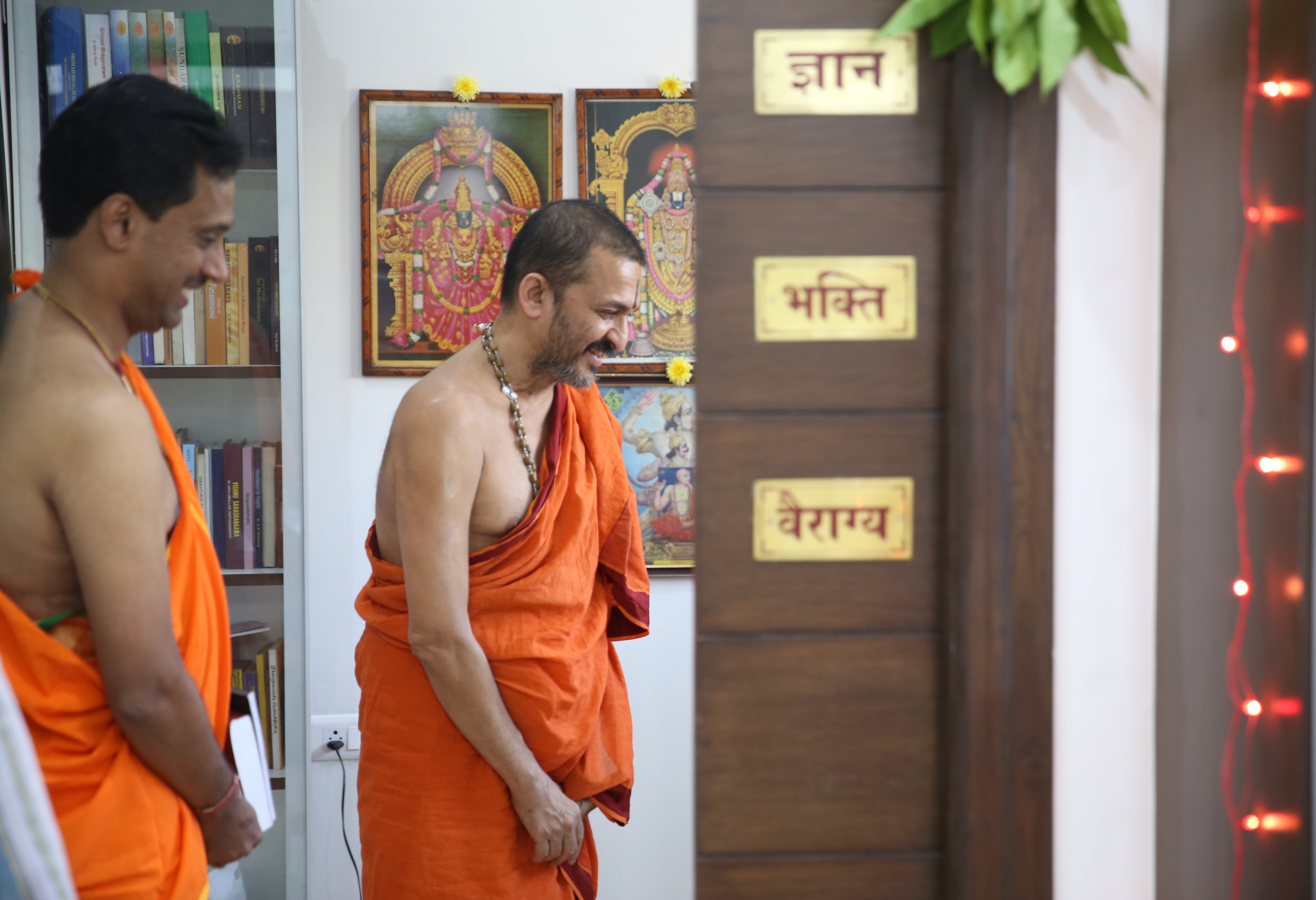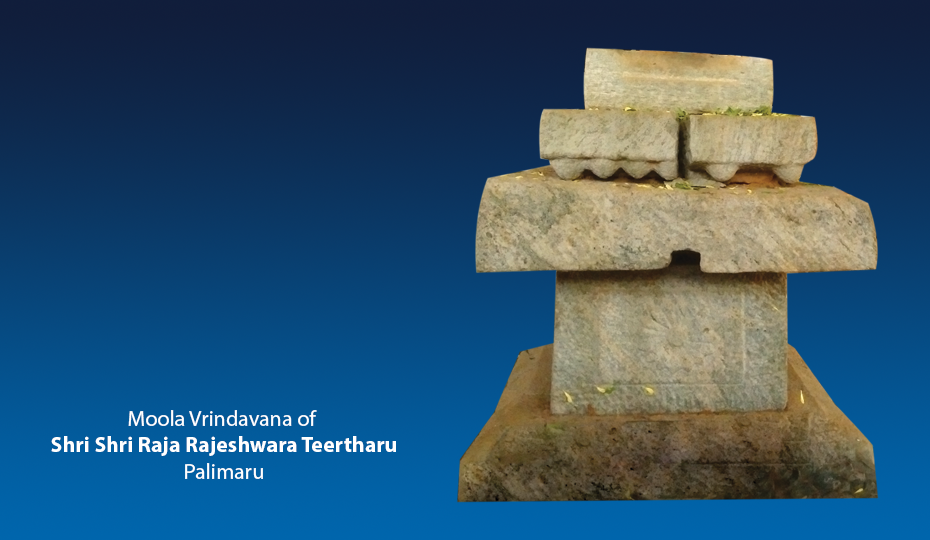After Śrī Hriṣīkēṣa Tīrtha, one of the most illustrious seers who came in the lineage of the Palimāru Maṭa was Śrī Rājarājēshwara Tīrtha. He was a distinguished seer who illumined not only the lineage of Palimāru Maṭa but also the lineage of the great sages of Bhārata through his poetic skill and works. He is the sixth seer in the lineage of Palimāru Maṭa and is surmised to have been born circa 1380. While his preceptor, Śrī Aparājita Tīrtha was still in reign, Śrī Vidyāmurti Tīrtha initiated Śrī Rājarājēshwara Tīrtha into sainthood.
Śrī Rājarājēshwara Tīrtha was a spontaneous poet. In recognition of his erudition and poetic skills, the King of the province of Mangalooru (Vīrapratāpa Dēvarāya II) donated the land of Kāntāvara to him. An epigraph corroborating this event is preserved at the Kāntāvara Maṭa to this day.
His works : Rāmasandēśa and Mangalāṣṭaka are two compositions of Rājarājēshwara Tīrtha that are available with us today.
Rāmasandēṣa is a poetic message analogous to Mēghasandēṣa of Kālidāsa. It dwells upon the message sent by the protagonist of the poem, Śrī Rāmachandra to Sīta through Hanumanta. It also describes the landscape that Hanumanta passes through en route to Lanka especially the beautiful and idyllic Tulava province. It maybe noted that Hamsasandēṣa composed by Vēdānta Dēsika is a poem with a similar message. Rāmasandēṣa is a spectacular poem and pips to the top the likes of Mēghasandēṣa-Hamsasandēṣa. Śrī Rājarājēshwara Tīrtha conveys the entire epic in a concise form and simultaneously pours out his innate devotion towards Lord Rāma. It is pertinent to note that the profundity of the Rāmasandēṣa was such that Śrī Vishwapathi Tīrtha of Pējāwara Matha later composed a commentary thereon.
The other composition of Śrī Rājarājēshwara Tīrtha is the Mangalāṣṭaka. It is his magnum opus. The Mangalāṣṭaka has been accepted and revered by all irrespective of caste and creed. It is the most auspicious octet recited across households at daybreak. The eight verses are compact and lyrical. All the auspicious realities to be thought of in the morning are incorporated by Śrī Rajareshwara Tīrtha in this poem. Its popularity is such that no other morning prayer in the entire gamut of cultural literature matches up to this octet. This little lyrical has assimilated the entire cosmos within itself. In form, this composition is Vāmana but in its essence it is Trivikrama. This is a national hymn too – the RSS’ Ekatmata Stotra is pari materia in a certain limited way.
Today, during wedding ceremonies when the bride and groom exchange garlands or while the yagnōpavīta is worn during the sacred thread ceremony, these auspicious eight verses are recited by everyone.
The great composer-seer intended that it be recited by people on all auspicious and holy occasions. His resolve was enormous and the Lord who is worshipped by all the distinguished seekers, fulfilled his wish. Although this prayer was composed several centuries ago, its glory is still verdant. This exemplifies the formidable erudition of Śrī Rājarājēshwara Tīrtha.
Śrī Vidyādhīśa Tīrtha, the venerable reigning pontiff of the Palimāru Maṭa says Śrī Rājarājēshwara Tīrtha saw the existence of the Supreme Being in all sentient beings and non-sentient things; he thus brought to the fore the omniscience and omnipresence of the Supreme Being.
The Mangalāṣṭaka succinctly meditates upon and pays obeisance to the following:
- Lord Viṣṇu, being the Supreme and His consort, Lakshmī
- Various deities in the descending order
- The numerous seers who have showered munificence on mankind
- The great kings who ruled over our land
- The geographical grandeur of this sacred land – its mountains
- The rivers that flow across this great land and sanctify us
- The eternal Vēdas, Upaniṣads, Purāṇas onwards to the spiritual literary works
- The zodiac, stars and the constellations
His legacy : Such an illustrious poet-saint, before adorning the pontificate, submitted the material and non-material wealth to Lord Rāma in the sannidhi of his guru and attained the feet of Lord Rāma at a very young age. His ways are inscrutable! Had he lived longer, as a pre-eminent poet in the lineage of the Palimāru Maṭa, he would have probably bestowed us with some more sacred compositions. That will remain a matter of conjecture.
The first Brindavana available in the lineage of Palimāru Maṭa is that of Śrī Rājarājēshwara Tīrtha and is located in Palimāru kshētra. The Maṭa of Śrī Hrishīkēsha Tīrtha was establised at Palimāru village during the time of Śrī Rājarājēshwara Tīrtha. Back then itself, it came to be known as Palimāru Maṭa. It is our misfortune that no records are available pertaining to the date when Śrī Rājarājēshwara Tīrtha attained Brindavana.
However, his ārādhana is celebrated on the full moon day of the Chaitra month every year at Palimāru to date (8th April this year). Besides, in remembrance of him and his greatness, every year an eminent scholar well versed in Vēdānta is conferred with the Śrī Rājarājēshwara Award and honoured by the Palimāru Maṭa. Though the lifespan of Śrī Rājarājēshwara Tīrtha was short, as a great and illustrious torch bearer of the Dvaita Siddhanta of Āchārya Madhwa, as the author of the Mangalāṣṭaka, his distinction and grace on us will remain forever.

Ever engaged in the sadhana of Srimadvaishnava Siddhanta of our Guru, Acharya Madhwa and all the Yatis and Dasas who have blazed this noble path. May HVG bless us all

This is a Great Article & your ‘Sri Krishnayana’ article is beautiful.
Dhanyavaada
Do you have a copy of Rama Sandesha. Can you kindly upload the same
His time period ?